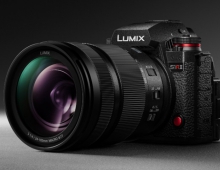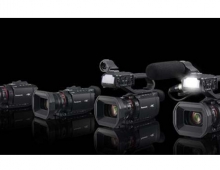
Panasonic to Launch World's Smallest SLR Camera
Panasonic will launch the world's smallest digital single-lens reflex (SLR) camera, targeting female users who want a high-performance machine that does not weigh too much.
SLR cameras, high-end models with interchangeable lenses, are the fastest growing and most lucrative segment of the digital camera market. But some compact camera users are reluctant to move up to SLR models because they are bulkier and heavier.
Panasonic's new Lumix model, DMC-G1, is 27 percent smaller than its existing DMC-L10 SLR camera, and weighs 385 grams. Based on the new Micro Four Thirds System standard, the LUMIX G1 eliminates the internal mirror structure that defines digital single-lens reflex (DSLR) cameras, thus reducing the size and weight by nearly half. With the mirror-less system, the G1?s flange back, which is the distance between the mount and the image sensor, has been reduced from 40 mm ? as specified in the Four Thirds System ? to approximately 20 mm.
The G1?s compact size can also be attributed to its electronic full-time Live View Finder, as opposed to a conventional optical viewfinder. The electronic Live View Finder, with a high-resolution 1,440,000-dot equivalent, allows a the user to shoot the exact image the camera sees while also displaying information about the camera?s settings through the view finder. The G1 also features a clever built-in eye sensor, so the camera can detect when the user is nearing the view finder and automatically switches off the LCD, thus conserving battery life. Also, the Live View Finder has a 1.4x (0.7x on a 35mm equivalent) magnification and when using the G1 in manual focus mode, the frame in the view finder or LCD will enlarge by 5x or 10x (can adjust using the dial).

The G1 introduces a new Contrast AF (Auto Focus) function. Users can choose from a wide-range of AF modes, including multiple-area AF with up to 23 focus areas, 1-area AF with a selectable focus area, Face Detection, and AF Tracking.
Users familiar with point-and-shoot digital cameras, and new to the world of advanced interchangeable lens cameras, will benefit from Panasonic?s Intelligent Auto (iA) mode. When in iA mode, the G1 will detect the shooting condition and automatically adjust for the ultimate shooting results. Panasonic?s iA includes the following intuitive technologies.
The 12.1 Megapixel camera, also includes Live MOS Sensor that makes it possible to read four channels of data simultaneously and deliver 60 frames-per-second full-time Live View images.
The Venus Engine HD enhances noise reduction and provides independent gradation control for each of the R, G and B colors.
With an optional HDMI cable, the G1 can connect to an HDMI-capable High Definition television.
The LUMIX G1 will come with color variety ? with availability in black, blue and red models.

The new machine will go on sale in Japan on October 31. Matsushita it expected a package of the camera body and a lens unit to sell for 90,000 yen ($839.5).
Overseas launches are scheduled for late October and early November. In the U.S., the G1 will be available in mid-November as a kit with the new LUMIX G VARIO 14-45mm/F3.5-5.6 ASPH/MEGA O.I.S lens. Also available in November, and announced today, is the LUMIX G VARIO 45-200mm/F4.0-5.6/MEGA O.I.S.lens.
Pansonic was the world's seventh-largest digital camera maker with a 7.1 percent share in 2007, according to data from research firm IDC. In the digital SLR camera market, which is dominated by Canon and Nikon, its share stood at 0.5 percent last year.
Panasonic's new Lumix model, DMC-G1, is 27 percent smaller than its existing DMC-L10 SLR camera, and weighs 385 grams. Based on the new Micro Four Thirds System standard, the LUMIX G1 eliminates the internal mirror structure that defines digital single-lens reflex (DSLR) cameras, thus reducing the size and weight by nearly half. With the mirror-less system, the G1?s flange back, which is the distance between the mount and the image sensor, has been reduced from 40 mm ? as specified in the Four Thirds System ? to approximately 20 mm.
The G1?s compact size can also be attributed to its electronic full-time Live View Finder, as opposed to a conventional optical viewfinder. The electronic Live View Finder, with a high-resolution 1,440,000-dot equivalent, allows a the user to shoot the exact image the camera sees while also displaying information about the camera?s settings through the view finder. The G1 also features a clever built-in eye sensor, so the camera can detect when the user is nearing the view finder and automatically switches off the LCD, thus conserving battery life. Also, the Live View Finder has a 1.4x (0.7x on a 35mm equivalent) magnification and when using the G1 in manual focus mode, the frame in the view finder or LCD will enlarge by 5x or 10x (can adjust using the dial).

The G1 introduces a new Contrast AF (Auto Focus) function. Users can choose from a wide-range of AF modes, including multiple-area AF with up to 23 focus areas, 1-area AF with a selectable focus area, Face Detection, and AF Tracking.
Users familiar with point-and-shoot digital cameras, and new to the world of advanced interchangeable lens cameras, will benefit from Panasonic?s Intelligent Auto (iA) mode. When in iA mode, the G1 will detect the shooting condition and automatically adjust for the ultimate shooting results. Panasonic?s iA includes the following intuitive technologies.
The 12.1 Megapixel camera, also includes Live MOS Sensor that makes it possible to read four channels of data simultaneously and deliver 60 frames-per-second full-time Live View images.
The Venus Engine HD enhances noise reduction and provides independent gradation control for each of the R, G and B colors.
With an optional HDMI cable, the G1 can connect to an HDMI-capable High Definition television.
The LUMIX G1 will come with color variety ? with availability in black, blue and red models.

The new machine will go on sale in Japan on October 31. Matsushita it expected a package of the camera body and a lens unit to sell for 90,000 yen ($839.5).
Overseas launches are scheduled for late October and early November. In the U.S., the G1 will be available in mid-November as a kit with the new LUMIX G VARIO 14-45mm/F3.5-5.6 ASPH/MEGA O.I.S lens. Also available in November, and announced today, is the LUMIX G VARIO 45-200mm/F4.0-5.6/MEGA O.I.S.lens.
Pansonic was the world's seventh-largest digital camera maker with a 7.1 percent share in 2007, according to data from research firm IDC. In the digital SLR camera market, which is dominated by Canon and Nikon, its share stood at 0.5 percent last year.





















